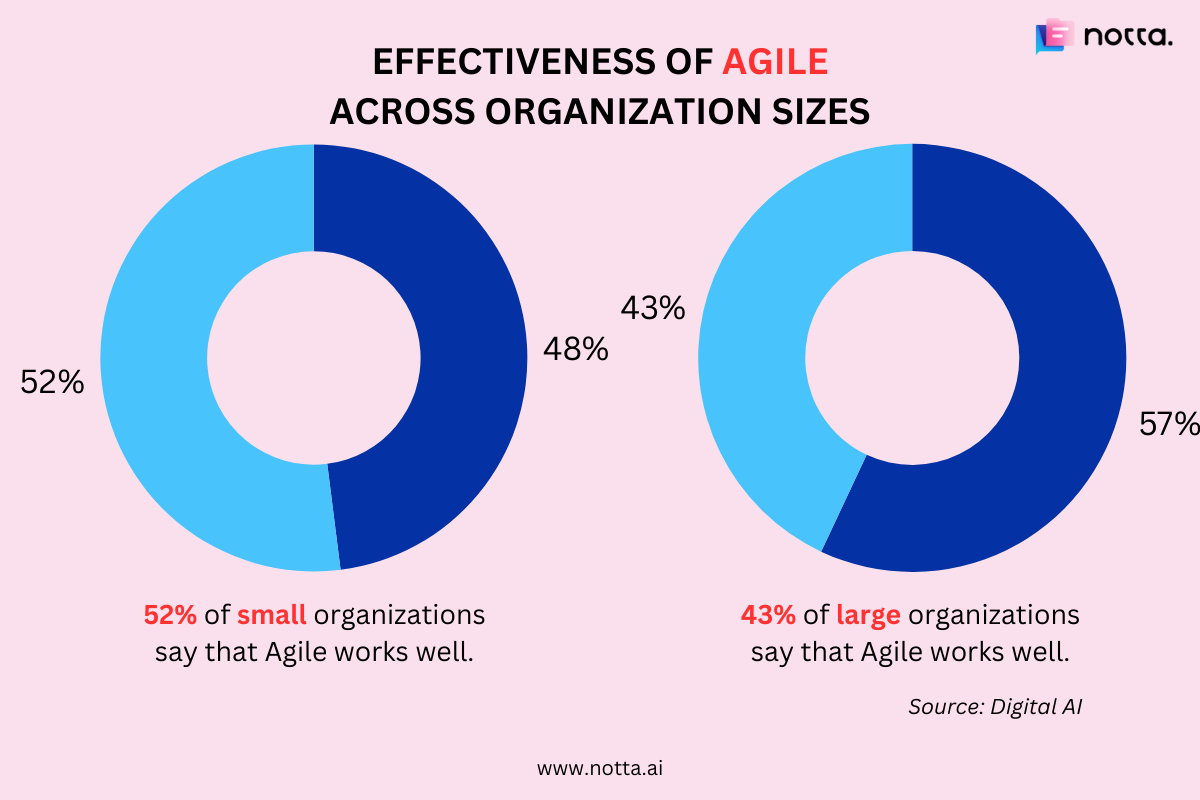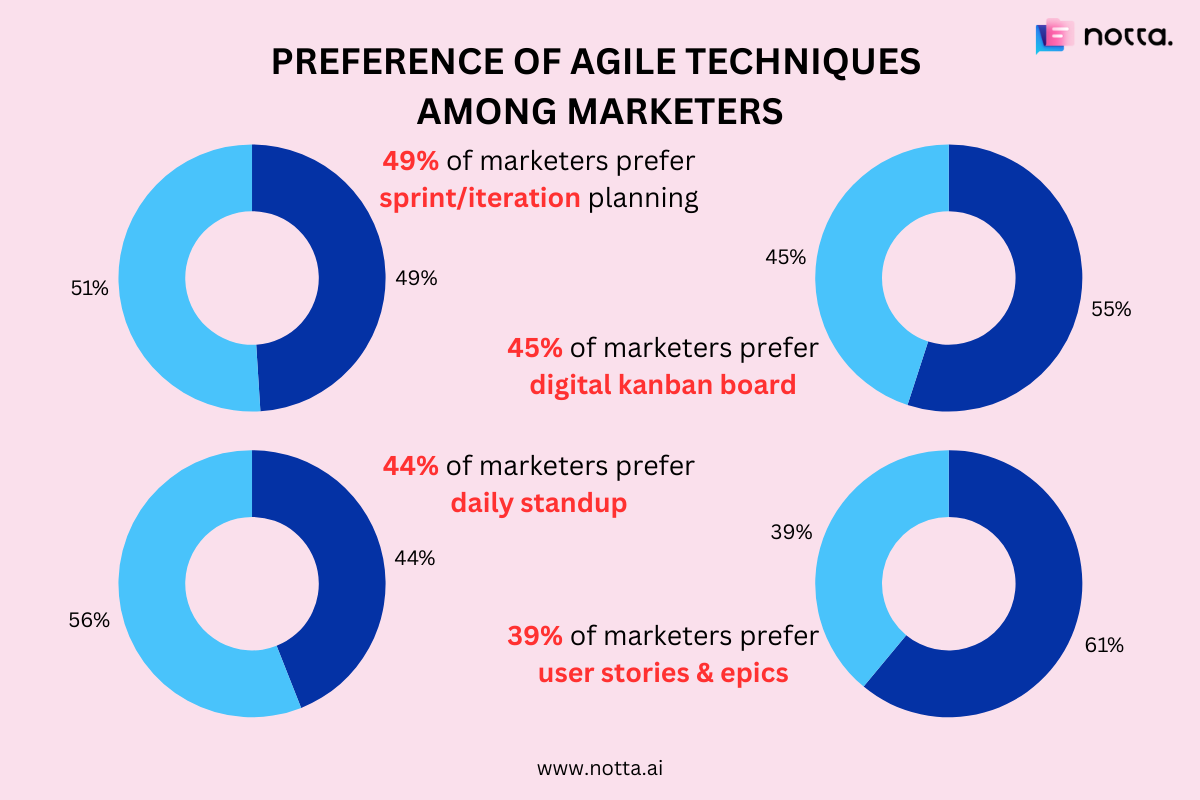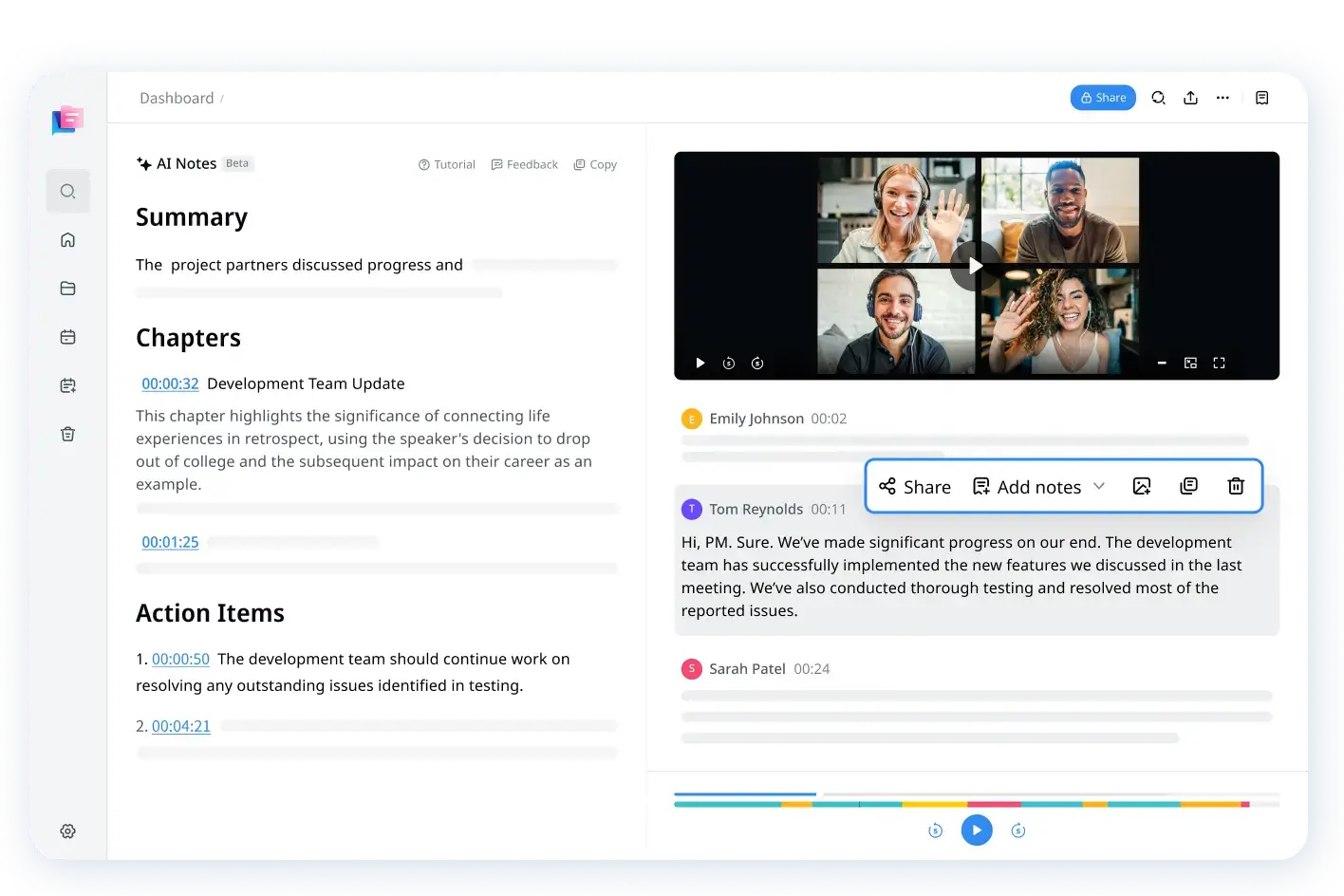
50+ Agile Statistics You Need to Know in 2025
Record, transcribe and summarize conversations with one click.
Agile has been amongst the most preferred development frameworks for several years now. One of the main reasons for this is its individual-centric approach, and this has led to several Fortune 500 companies adopting it as their primary choice.
But what is the state of Agile in today’s market? How many companies use it for their software development needs, and what benefits does it offer? In this guide, I take you through 50+ Agile statistics so you can benefit from a deeper insight into Agile’s prominence in the It world today.
Agile statistics at a glance
While there’s a lot to understand about Agile, from its adoption, benefits, challenges, and future trends, I’ve listed some of the key statistics and insights in the summary below.
According to the 17th Annual State of Agile Report, the fastest-growing adopters of Agile are Engineering and R&D teams. They comprise 48% of Agile practitioners, which is a 16% increase from the 2022 figures.
The top two reasons organizations choose Agile are for prioritizing delivery measuring business value, and accelerating time to market.
86% of marketers plan on moving some or all of their teams to using Agile methodologies.
For the first time in seven years, the 7th Annual State of Agile Marketing Report found that hybrid frameworks are not the most popular among marketers. This is because markets are increasingly adopting Agile and are more comfortable with it.
According to the State of Kanban Report 2022, 87% of respondents noted that the Kanban Method was more effective than previous ways of managing work.
Overview of Agile methodology
Agile was formally launched in 2001 when a group of 17 technologists introduced what’s known as the Agile Manifesto. While this wasn’t the first development framework to exist, especially with the waterfall methodology being prominent before it, it revolutionized the software development landscape.
The Agile Manifesto outlines four main values upon which it’s founded. These include:
The prominence of individuals and interactions over processes and tools
Working software superseding comprehensive documentation
Customer collaboration over contract negotiation
Responding to change by following a comprehensive plan
The Agile methodology came about as a result of the initial growth of Internet applications. With these often being developed by smaller teams at startups, they didn’t follow the traditional enterprise-level approach that involved comprehensive documentation upfront. Additionally, given the pace of change brought about by the internet revolution, those developing these apps also needed to adapt to change rather quickly.
The response to this was the launch of the Agile Manifesto, as these technologists realized that they were practicing software development differently than the waterfall methodology.
The Agile Alliance worked continuously to further the use of the Agile methodology, and after 2012, the use of Agile was also accompanied by success stories of how adopting this lightweight methodology was beneficial.
Today, Agile adoption among development teams in the software industries is at an all-time high.
Agile adoption and usage statistics
Agile adoption has witnessed a sharp increase over the years, with small and large organizations across industries slowly waking up to its benefits. In this section, I’ll take you through some key statistics that highlight the scale of Agile adoption and its usage across industries.
How many companies use Agile?
With Agile’s increasing adoption, what does the landscape look like in terms of the scale of the companies that already use it? You’ll be interested to know that Agile has been adopted across a range of sectors, and in this section, I’ll take you through some key statistics to help set the stage for its use.
According to the 17th Annual State of Agile Report, the fastest-growing adopters of Agile are Engineering and R&D teams. They comprise 48% of Agile practitioners, which is a 16% increase from the 2022 figures.
Additionally, 28% of business operations and 20% of marketing teams have adopted Agile principles.
Those working in smaller organizations, as opposed to medium and large ones, are more likely to say that customer support services, marketing, and sales have adopted Agile principles.
32% of respondents to the report stated that business leaders are leading the way towards an organization-wide Agile transformation.
Another 31% stated that Agile practices are limited to individual technical teams, whereas 20% stated that the Agile transformation is only led by the fice of the CIO or the CTO.
86% of marketers plan on moving some or all of their teams to using Agile methodologies.
Agile adoption
The adoption of Agile methodologies can be seen across industries and also within different departments. These span across the various Agile frameworks, and the statistics below offer an insight into this aspect.
According to a 2019 study conducted by KPMG, 81% of respondents stated that they’d started their Agile transformation in the last three years.
According to the Pulse of the Profession Report 2024, 53% of respondents in the Information Technology industry report using Agile always or often. 55% use a hybrid approach often, whereas 52% report using a predictive approach often.
The Financial Services sector saw 58% stating that they use Agile always or often, whereas the number stood at 53% for a hybrid approach and 45% for a predictive approach.
71% of respondents to the 17th Annual State of Agile Report’s survey stated that they use Agile in their software development cycle (SDLC).
According to the same report, the top benefits of using Agile are improved collaboration and better alignment with the business.
Scrum remains the most popular team-level Agile methodology, with 63% stating they prefer it over others. This has been the case since the Annual State of Agile Report from 2006.
52% of small companies report that Agile is working very or somewhat well for them, compared to 43% of large companies. This demonstrates the preference for Agile among smaller organizations globally.

The top two reasons organizations choose Agile are for prioritizing delivery measuring business value, and accelerating time to market.
In 2022, 71% of respondents to the State of Agile Report stated that they were either somewhat or very satisfied with Agile, but in 2023, the number dropped to 59%.
47% stated that the business side of their organizations was slow to embrace Agile as a result of a generalized resistance to organizational change.
37% stated that business teams simply don’t understand Agile or what it can do, and 27% stated that there isn’t enough training offered.
Companies forcing the adoption of “hybrid approaches to software development” was cited by 46% as the reason why Agile wasn’t scaling.
98% of marketers stated that their Agile implementation has been successful.
Statistics on different Agile frameworks
Agile has various different frameworks, from Scrum to Kanban and Lean, among others. Each of them has its pros and cons and is preferred by different organizations based on a range of different factors. The statistics in this section highlight the use of these different frameworks.
How many Agile frameworks are there?
There are several important Agile frameworks for both teams (Scrumban, Scrum, Kanban) and entire organizations (SAFe, LeSS). Here’s how they’re used across different industries.
The Scaled Agile Framework (SAFe) is the most likely choice for any enterprise among the various Agile frameworks, but only 26% of respondents stated they use SAFe. This marks a 50% decrease from the previous year.
19% stated that they use Scrum@Scale or Scrum of Scrums, whereas 4% stated they use Enterprise Scrum.
In terms of the use of team-level Agile tools, 62% of companies use Atlassian Jira, 32% use Mural/Miro, and 25% use either Microsoft Excel or Microsoft Project.
According to the 16th Annual State of Agile Report, almost 9 out of 10 respondents stated that they’re using Scrum, whereas about half are using Kanban.
For the first time in seven years, the 7th Annual State of Agile Marketing Report found that hybrid frameworks are not the most popular among marketers. This is because markets are increasingly adopting Agile and are more comfortable with it.
The same report found that Kanban is the most closely followed Agile framework at 25% and ties with Scrum at 25%, While a Hybrid/Scrumban framework also stands at 25%.
Among the various Agile techniques and practices, 49% of marketers stated that they use Sprint/Iteration planning, 45% use Digital Kanban board, 44% use Daily standup, and 39% use user stories and/or epics.

In terms of the use of Agile marketing, the impact of various factors that influenced the decision is that 64% found that Agile marketing is more important in the competitive landscape, while 30% stated that it had no impact.
Choosing the right frameworks
There are various factors that drive teams and organizations to choose one framework over another. This section highlights some key insights that can help you understand why organizations choose certain frameworks and how they benefit them.
With respect to the economic climate, 55% stated that Agile marketing is more important, whereas 29% said it had no impact, and another 16% said that it’s less important.
In terms of marketing budgets, 52% said that Agile marketing is more important, 35% stated that it has no impact, and 13% stated that it’s less important.
According to the State of Kanban Report 2022, 87% of respondents noted that the Kanban Method was more effective than previous ways of managing work.
50% of respondents found Kanban to be much more effective, 37% found it more effective, and 12% found it to be somewhat the same.
Agile benefits and impact statistics
Agile offers developers a whole host of benefits, and its impact has been felt year after year across multiple industries. This section highlights some of the key statistics and findings with respect to its impact on team productivity and efficiency and on project success rates.
Team productivity and efficiency
What benefits does Agile offer in terms of team productivity and efficiency? Does it really help improve quality and save time in a sprint review meeting or in other tasks? The statistics below offer the answers to these, among several other key questions.
Research by McKinsey and Co. shows that 93% of Agile organizations reported better customer satisfaction than non-Agile teams. 73% also reported better employee engagement, while 93% reported better operational performance.
Another study found that Agile teams doing full Scrum have 250% better quality than their counterparts who do no estimating whatsoever.
Building a strong Agile culture results in a happier, more passionate, and engaged workforce and results in a 277% increase in commercial performance.
The 2nd International State of Agile HR 2022 report found that the top reason for adopting Agile methods was to motivate current employees. 65% also believe that the COVID-19 pandemic positively impacted the adoption of Agile.
Project success rates
Agile implementation can have a major impact on project success rates as well. It helps align teams with their business needs, among several other benefits. The statistics below shine some light on this aspect.
According to the MPI Pulse of the Profession 2023 Report, 39% of the respondents employing an Agile project management approach had the highest average project performance rate, with an overall project success rate of 75.4%.
Business units that have fully embraced an Agile model demonstrated far greater resilience in facing the challenges thrown at them during the COVID-19 pandemic.
Almost three in five Agile practitioners are satisfied because of a better alignment with their business needs. 59% reported enhanced collaboration, while 57% reported better alignment with their organization’s objectives.
Africa has the highest Agile culture score at 79% of all organizations that were interviewed across all continents, whereas North America had a score of 32%.
Statistics on challenges in Agile implementation
To what extent is Agile implemented across organizations? What challenges do organizations face? Several surveys suggest that resistance to a change in culture and a lack of support from the top management are key challenges to Agile implementation. The statistics below offer some more details.
Close to 75% of respondents to a KPMG survey state that their organizations lack the support for an Agile culture. This is regardless of the maturity of their Agile practices.
Research by McKinsey found that 46% of respondents agree or strongly agree that during sprint planning, their teams ensure that everyone is fully utilized.
62% found that top management believed that Agile has no implications for them, while 32% stated that Agile transformation had no support from top management. 59% stated that culture and performance management were key challenges in their shift to Agile.
According to the 17th State of Agile Report, some of the leading causes for the unsuccessful delivery of Agile were company culture at 41%, lack of management support at 38%, ineffective management collaboration at 26%, and an inability to continuously prioritize work at 25%.
Agile future statistics
The future of Agile looks bright, especially with an increasing number of businesses realizing its potential. Be it in IT processes or across industries like software, telecommunications, and healthcare, the future of Agile certainly appears bright. The statistics in this section paint a detailed picture for you.
Emerging trends in Agile
As with any development framework, there are certain emerging trends with respect to Agile, too. The statistics below offer some key insights into these trends.
According to a study by PwC, organizations are increasingly adopting Agile methodologies for IT development and their ongoing maintenance, showing that they’re twice as likely to succeed than traditional Waterfall methodologies and 50% more likely to meet their deadlines and budgets.
Over two in five respondents say that improvements in end-to-end visibility and traceability would be most valuable for their DevOps practice.
One of the newest Agile trends is design-thinking, which is a human-centered approach to innovation that “takes inspiration from the designer’s toolkit to integrate the needs of the people,” as stated by the CEO of IDEO.
The adoption of hybrid project management has steadily risen over the past couple of years. It increased from 20% in 2020 to 31.5% in 2023.
Agile in different industries
Agile has been implemented across a range of industries to varying degrees. Find out the breakdown of its use below.
49% of respondents to the 16th Annual State of Agile Report stated that they apply Agile practices to the entire application delivery lifecycle.
According to the same report, 27% of the respondents used Agile in the technology industry, 18% in financial services, 8% in healthcare or pharma, 7% in the government, 5% in insurance, and 4% in telecommunications, among other industries.
How Notta can enhance Agile practices
Implementing and enhancing Agile practices in your organization over time requires consistent, effective communication. In today’s remote and hybrid landscapes, this often happens via video conferencing platforms like Zoom and Google Meet. As a result, it becomes essential to document every aspect of these meetings to ensure every team member is on the same page.
Whether it’s a sprint planning meeting, a sprint retrospective meeting, or a stand-up meeting, Notta can record and transcribe them for you.

Notta is an AI meeting assistant that records, transcribes, translates, and summarizes your meetings for you so you can focus on the discussion with your undivided attention. It offers several benefits, including:
Improving meeting efficiency: Notta’s real-time transcription feature can be handy during Agile ceremonies such as stand-ups and retrospectives, ensuring every individual has an accurate copy of what’s discussed. It also uses AI to capture and summarize the key points discussed.
Enhancing collaboration: Once Notta prepares your meetings’ transcripts, you can collaborate on them with your team in real-time. This makes collaboration quick and seamless, ensuring every member is on the same page.
Notta can be an essential addition to your tech stack, especially if you intend to switch over to or enhance your existing Agile processes. It ensures that every member is in the loop about every step of the process, taking away the task of manual note-taking from any one individual. Find out what Notta can do for you using its free trial today!
Notta offers the most integrated AI meeting notes, summaries, and action items so nothing gets missed.
The bottom line
Implementing Agile processes is one of the best ways of improving your team’s productivity and efficiency, and can have a lasting impact on employee engagement and retention, besides offering a host of other benefits. This guide has listed 50+ key Agile statistics that highlight its adoption, the industries it’s used in, its benefits, and challenges.
The process of adopting Agile methodologies can be lengthy, but it requires the right approach from the very outset. With Notta, you can ensure that one of the most critical aspects is taken care of, which is workplace communication. This way, you’ll leave no stone unturned in ensuring every team member is aware of the changes and receives the support and training they need while benefiting from accurate transcripts of every discussion.
References
Digital.ai: 17th Annual State of Agile Report
Agile Sherpas: 7th Annual State of Agile Marketing Report
Project Management Institute: Pulse of the Profession 2024
Digital.ai: 16th Annual State of Agile Report
Kanban University: State of Kanban Report 2022
Agile Sherpas: 6th Annual State of Agile Marketing Report
McKinsey and Co: An operating model for the next normal: Lessons from agile organizations in the crisis
Broadcom Software: The Impact of Agile Quantified
State of Agile Culture: Third State of Agile Culture Report
State of Agile HR: 2nd International State of Agile HR 2022
Project Management Institute: Pulse of the Profession 2023
McKinsey and Co: In pursuit of value-not work
IDEO: Design Thinking Defined
Project Management Institute: Future of Project Work